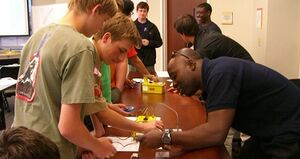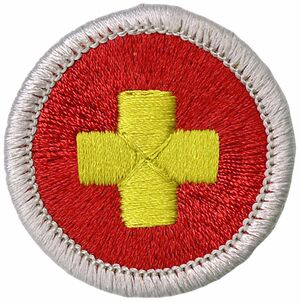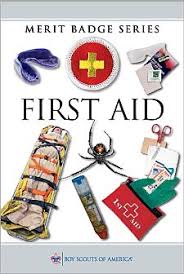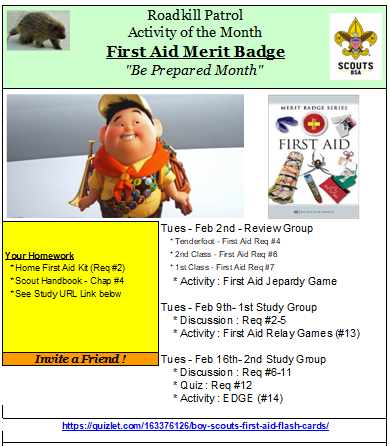First Aid Merit Badge Activity Planner: Difference between revisions
No edit summary |
|||
| Line 64: | Line 64: | ||
Most merit badge activities do best to have a "introduction" meeting where the patrol can discuss how to get started and to plan out their field trips. Send out the activity flyer in advance to use as an meeting agenda. Your scouts will then know what to expect. | Most merit badge activities do best to have a "introduction" meeting where the patrol can discuss how to get started and to plan out their field trips. Send out the activity flyer in advance to use as an meeting agenda. Your scouts will then know what to expect. | ||
First aid is promptly helping people who are suddenly sick (illnesses) or hurt (injuries or body damage). For example, first aid is used at accidents to help an injured person until they receive medical treatment (help by doctors, nurses or ambulances). First aid is also used to help people who suddenly become sick, until help arrives or they can be taken to medical care. | |||
A person does not need much equipment to give first aid. A package of things useful to give first aid is called a first aid kit. Lives can be saved even without a first aid kit. What is required is basic knowledge. First aid can be done just about anywhere that an emergency requires. In places far from hospitals, first aid may be the only help possible until the person can be taken to a hospital or clinic. | |||
Emergency medical dispatchers are trained in first aid, so that if there is an emergency, they can give the caller some information on what to do until the ambulance arrives. This can include the "C-A-B" listed below. | |||
Revision as of 13:05, 24 April 2020
| First Aid - each year it is the most popular merit badge earned by scouts and frequently their first badge earned on the trail to Eagle. Come have fun with First Aid. |
|---|
'Patrol Leader Merit Badge Planning Guide for the FirstAid Merit Badge
*** Activities for the Youth Lead Patrol ***
Exploring FirstAid can be a fascinating youth adventure when done right. Here are a few tips to help the patrol leader get started.
- Scouts may never add or subtract from the actual merit badge requirements
- This Planner is only a suggestion of different ideas to make working this Merit Badge both fun and easy.
- While doing the Worksheet is not a requirement for earning this badge, in many cases it can help you learn key concepts and track your progress.
A. Make Your Plan
- Merit Badge Activity Planning Tips - 14 tips for a successful patrol activity. Read carefully before you start your plan!
- Share Your Plan - Meet ahead of time with your patrol, scout leaders, parents and especially with the Merit Badge Counselor. Make changes to the plan as needed.
- Prepare Activity Flyer - Keep your fellow scouts informed - events, activities, pre-requisites and more.
| Patrol Activity | GREAT | Awesome MB to work as a patrol / Max Size 12 scouts |
|---|---|---|
| Virtual Field Trip | GREAT | Require presenter shares FirstAid in virtual meeting |
| Family Activity | POOR | Requires access to FirstAid Transmitter |
| Service Activity | FAIR | Useage in Emergency Preparedness Drills |
| S.T.E.M. Activity | GREAT | Learn how to use Modern Digital Technology |
| Field Trip | FAIR | Find a remote broadcast location |
| Duty-to-God | POOR | N/A |
| MB Day | GREAT | But only if you broadcast equipment. Many special FirstAid MB Day groups abound. |
| Overnighter | GREAT | Find a remote broadcast location |
| Summer Camp | GREAT | Pre-requisite: Scout Camp has their own broadcast transmitter |
Online Resources
- FirstAid Merit Badge Requirements: BoyScoutTrial.com lists all requirements, additional resources, activity worksheet, etc.
- FirstAid Merit Badge File Store: Online resources
- First Aid Merit Badge Worksheets: Worksheets are optional - but highly preferred by many MBC. When you find that many requirements say "discuss" - the worksheet can help you gather your thoughts beforehand.
- First Aid Merit Badge Booklet: Everything thing you need to know about FirstAid is right here. Get this study guide from either Amazon or your Troop Library, Merit Badge Counselor or Scoutmaster to Learn More About this Subject.
- First Aid @ Simple-Wikipedia: Get the basics quickly.
B. Introduction Meeting
Most merit badge activities do best to have a "introduction" meeting where the patrol can discuss how to get started and to plan out their field trips. Send out the activity flyer in advance to use as an meeting agenda. Your scouts will then know what to expect.
First aid is promptly helping people who are suddenly sick (illnesses) or hurt (injuries or body damage). For example, first aid is used at accidents to help an injured person until they receive medical treatment (help by doctors, nurses or ambulances). First aid is also used to help people who suddenly become sick, until help arrives or they can be taken to medical care.
A person does not need much equipment to give first aid. A package of things useful to give first aid is called a first aid kit. Lives can be saved even without a first aid kit. What is required is basic knowledge. First aid can be done just about anywhere that an emergency requires. In places far from hospitals, first aid may be the only help possible until the person can be taken to a hospital or clinic.
Emergency medical dispatchers are trained in first aid, so that if there is an emergency, they can give the caller some information on what to do until the ambulance arrives. This can include the "C-A-B" listed below.
News Flash
C. Study Hall
While some scouts may be adept at self-study, others may do better in a small group setting and taking notes on worksheets. You can facilitate discussion by asking them why each of the principles intruduced here would be relevant. Schedule one or more patrol meetings to work this merit badge.
- Prepare an agenda and make Assignments as needed.
- What learning materials are needed for this meeting? Who will bring them?
- Watch video, powerpoint or other online tutorial.
- Update one or more sections of the merit badge worksheet. (Ask the Merit Badge Counselor which requirements are relevant here.)
- Invite the Merit Badge Counselor to join your Study Hall.
- Plan and Prepare for the Patrol Field Trip Activities (see below).
D. Homework
Assign one or more requirements that the scout can do at home, perhaps as a family activity.
E. Field Trip
Meaningful Field Trips will add much to the adventure here. Consider including one or more of the following:
- Merit Badge Campout: Field Trip overnight experience can get you a lot closer to the action and to see things in a different way.
- Facility Tour: A day trip to a musuem, gallery, or factory of a related nature.
- Get Dirty Day: Setup a work station in your garage, backyard, park or other location for a truely "hands-on" experience.
- Service Project: There many organizations connected with this merit badge that could use your assistance.
- Contact the destination venue. Confirm that they can assist with the Field Trip Requirements. Reserve your Event Dates. Get Scoutmaster Assistance as necessary.
- Patrol Historian should be ready to take pictures on this activity to report back on the next troop blog, newsletter or court of honor.
F. Final Meeting

You will probably need to schedule one patrol night for a follow up meeting with your Merit Badge Counselor. He/She will use this opportunity to meet with scouts either individually are as a group to review your activities, study worksheets, knowledge and accomplishments before signing off your Merit Badge Blue Card.
- Activity Reflection: Use this meeting for scouts to ask questions and to reflect on what they gained personally from this adventure. You can also have a discussion on what future opportunities are here.
- Court of Honor Exhibit: Pictures, handiwork and other memorabilia from this adventure will make for a great presentation at the next Scout Troop Court of Honor.
G. See Also
- 9 Things to Know about Merit Badges - BoysLife.org - There are more than 135 merit badges. By earning them, you can learn about sports, crafts, science, trades, business, and future careers. Here’s how to get the most out of your merit badge experience.
Related Merit Badges
Sometimes it is easier by doing two or more merit badges together as a joint activity:
- Emergency Preparedness - First Aid MB is Req #1 for Emergency Preparedness! Both are required for Eagle Rank Advancement.



